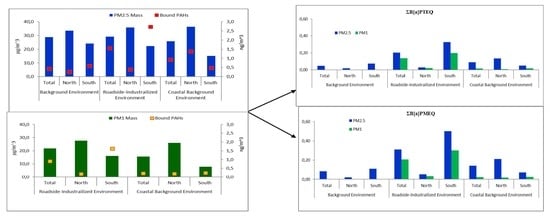Levels, Sources and Health Risk of PM2.5 and PM1-Bound PAHs across the Greater Athens Area: The Role of the Type of Environment and the Meteorology
Abstract
:1. Introduction
2. Materials and Methods
2.1. Field Campaign
2.2. Data Analysis
2.2.1. Meteorology
2.2.2. Air Mass Backward Trajectories
2.2.3. Source Apportionment
2.2.4. Health Risk Assessment
3. Results and Discussion
3.1. Influence of the Type of the Environment
3.1.1. PM Mass and PAHs
3.1.2. Source Identification
3.1.3. PM Toxicity
3.2. Influence of the Meteorology
3.2.1. PM Mass and PAHs
3.2.2. Source Identification
3.2.3. PM Toxicity
3.2.4. Special Characteristics of the Selected Days
4. Conclusions
- The obtained pollution scheme was a mixed result of the simultaneous exposure to a variety of pyrogenic and petrogenic sources;
- The characteristics of the environment and the intensity of the emissions were the critical points for the enhanced recorded concentration levels;
- As it is clearly illustrated from the FEI-GREGAA emission inventory, the traffic input was determinant for the quantified PM2.5 mass load while in the case of the PAHS’ budget, the key was the residential heating sector;
- The group of the HMW-PAHs, mainly originated from combustion processes, was predominant in both PM2.5 and PM1 fractions;
- In the case of the toxicity of the PAHs’ mixture, the peak was registered, as it was expected, at the most multi-impacted location. However, highlighting the particular importance of the configured characteristics of the air masses arriving to a receptor area from regional/large scale distances, especially for the background locations, the coastal PM2.5 were more carcinogenic/ mutagenic than the one of the background environment within the basin;
- The obtained carcinogenic schemes were differentiated not only with the mutagenic one but also between the two fractions. More complicated was the configured pattern of the mutagenic potency;
- None a common trend was detected between the dominant hydrocarbon and the congener that contributed more to the potential risk of the PAHs’ mixture. Therefore, the incorporation of as many hydrocarbons as possible besides B[a]P, is a prerequisite.
Supplementary Materials
Author Contributions
Funding
Acknowledgments
Conflicts of Interest
References
- Amodio, M.; Caselli, M.; de Gennaro, G.; Tutino, M. Particulate PAHs in two urban areas of Southern Italy: Impact of the sources, meteorological and background conditions on air quality. Environ. Res. 2009, 109, 812–820. [Google Scholar] [CrossRef] [PubMed]
- Dubey, J.; Kumari, K.M.; Lakhani, A. Chemical characteristics and mutagenic activity of PM2.5 at a site in the Indo-Gangetic plain, India. Ecotoxicol. Environ. Saf. 2015, 114, 75–83. [Google Scholar] [CrossRef] [PubMed]
- Hanedar, A.; Alp, K.; Kaynak, B.; Baek, J.; Avsar, E.; Odman, M.T. Concentrations and sources of PAHs at three stations in Istanbul, Turkey. Atmos. Res. 2011, 99, 391–399. [Google Scholar] [CrossRef]
- Anastasopoulos, A.T.; Wheeler, A.J.; Karman, D.; Kulka, R.H. Intraurban concentrations, spatial variability and correlation of ambient polycyclic aromatic hydrocarbons (PAH) and PM2.5. Atmos. Environ. 2012, 59, 272–283. [Google Scholar] [CrossRef]
- Khan, M.F.; Latif, M.T.; Lim, C.H.; Amil, N.; Jaafar, S.A.; Dominick, D.; Nadzir, M.S.M.; Sahani, M.; Tahir, N.M. Seasonal effect and source apportionment of polycyclic aromatic hydrocarbons in PM2.5. Atmos. Environ. 2015, 106, 178–190. [Google Scholar] [CrossRef]
- Guzman-Torres, D.; Eiguren-Fernández, A.; Cicero-Fernández, P.; Maubert-Franco, M.; Retama-Hernández, A.; Villegas, R.R.; Miguel, A.H. Effects of meteorology on diurnal and nocturnal levels of priority polycyclic aromatic hydrocarbons and elemental and organic carbon in PM10 at a source and a receptor area in Mexico City. Atmos. Environ. 2009, 43, 2693–2699. [Google Scholar] [CrossRef]
- Hong, H.S.; Yin, H.L.; Wang, X.H.; Ye, C.X. Seasonal variation of PM10-bound PAHs in the atmosphere of Xiamen, China. Atmos. Res. 2007, 85, 429–441. [Google Scholar] [CrossRef]
- Hanedar, A.; Alp, K.; Kaynak, B.; Avşar, E. Toxicity evaluation and source apportionment of Polycyclic Aromatic Hydrocarbons (PAHs) at three stations in Istanbul, Turkey. Sci. Total Environ. 2014, 488, 437–446. [Google Scholar] [CrossRef]
- Akyuz, M.; Cabuk, H. Meteorological variations of PM2.5/PM10 concentrations and particle-associated polycyclic aromatic hydrocarbons in the atmospheric environment of Zonguldak, Turkey. J. Hazard. Mater. 2009, 170, 13–21. [Google Scholar] [CrossRef]
- Amador-Munoz, O.; Bazán-Torija, S.; Villa-Ferreira, S.A.; Villalobos-Pietrini, R.; Bravo-Cabrera, J.L.; Munive-Colín, Z.; Hernández-Mena, L.; Saldarriaga-Norena, H.; Murillo-Tovar, M.A. Opposing seasonal trends for polycyclic aromatic hydrocarbons and PM10: Health risk and sources in southwest Mexico City. Atmos. Res. 2013, 122, 199–212. [Google Scholar] [CrossRef]
- He, J.; Fan, S.; Meng, Q.; Sun, Y.; Zhang, J.; Zu, F. Polycyclic aromatic hydrocarbons (PAHs) associated with fine particulate matters in Nanjing, China: Distributions, sources and meteorological influences. Atmos. Environ. 2014, 89, 207–215. [Google Scholar] [CrossRef]
- Kassomenos, P.; Flocas, H.A.; Lykoudis, S.; Petrakis, M. Analysis of Mesoscale Patterns in Relation to Synoptic Conditions over an Urban Mediterranean Basin. Theor. Appl. Climatol. 1998, 59, 215–229. [Google Scholar] [CrossRef]
- Pateraki, S.; Maggos, T.; Michopoulos, J.; Flocas, H.A.; Asimakopoulos, D.N.; Vasilakos, C. Ions species size distribution in particulate matter associated with VOCs and meteorological conditions over an urban region. Chemosphere 2008, 72, 496–503. [Google Scholar] [CrossRef] [PubMed]
- Pateraki, S.; Asimakopoulos, D.N.; Bougiatioti, A.; Maggos, T.; Vasilakos, C.; Mihalopoulos, N. Assessment of PM2.5 and PM1 chemical profile in a multiple-impacted Mediterranean urban area: Origin, Sources and Meteorological dependence. Sci. Total Environ. 2014, 479, 210–220. [Google Scholar] [CrossRef] [PubMed]
- Fameli, K.M.; Assimakopoulos, V.D. Development of a road transport emission inventory for Greece and the Greater Athens Area: Effects of important parameters. Sci. Total Environ. 2015, 505, 770–786. [Google Scholar] [CrossRef] [PubMed] [Green Version]
- Mantas, E.; Remoundaki, E.; Halari, I.; Kassomenos, P.; Theodosi, C.; Hatzikioseyian, A.; Mihalopoulos, N. Mass closure and source apportionment of PM2.5 by Positive Matrix Factorization analysis in urban Mediterranean environment. Atmos. Environ. 2014, 94, 154–163. [Google Scholar] [CrossRef]
- Andreou, G.; Rapsomanikis, S. Polycyclic aromatic hydrocarbons and their oxygenated derivatives in the urban atmosphere of Athens. J. Hazard. Mater. 2009, 172, 363–373. [Google Scholar] [CrossRef]
- Pateraki, S.; Bairachtari, K.; Kantarelou, V.; Manousakas, M.-I.; Eleftheriadis, K.; Vasilakos, C.; Assimakopoulos, V.D.; Maggos, T. The traffic signature on the vertical profile of different sized particles in an urban roadside environment. Sci. Total Environ. 2019, 646, 448–459. [Google Scholar] [CrossRef]
- Mandalakis, M.; Τsapakis, M.; Τsoga, A.; Stephanou, E.G. Gas–particle concentrations and distribution of aliphatic hydrocarbons, PAHs, PCBs and PCDD/Fs in the atmosphere of Athens (Greece). Atmos. Environ. 2002, 36, 4023–4403. [Google Scholar] [CrossRef]
- Sitaras, I.E.; Bakeas, E.B.; Siskos, P.A. Gas/particle partitioning of seven volatile polycyclic aromatic hydrocarbons in a heavy traffic urban area. Sci. Total Environ. 2004, 327, 249–264. [Google Scholar] [CrossRef]
- Vasilakos, C.; Levi, N.; Maggos, T.; Hatzianestis, J.; Michopoulos, J.; Helmis, C. Gas–particle concentration and characterization of sources of PAHs in the atmosphere of a suburban area in Athens, Greece. J. Hazard. Mater. 2007, 140, 45–51. [Google Scholar] [CrossRef] [PubMed]
- Mantis, J.; Chaloulakou, A.; Samara, C. PM10-bound polycyclic aromatic hydrocarbons (PAHs) in the Greater Area of Athens, Greece. Chemosphere 2005, 59, 593–604. [Google Scholar] [CrossRef] [PubMed]
- Valavanidis, A.; Fiotakis, K.; Vlahogianni, T.; Bakeas, E.B.; Triantafillaki, S.; Paraskevopoulou, V.; Dassenakis, M. Characterization of atmospheric particulates, particle-bound transition metals and polycyclic aromatic hydrocarbons of urban air in the centre of Athens (Greece). Chemosphere 2006, 65, 760–768. [Google Scholar] [CrossRef] [PubMed]
- Fameli, K.M.; Assimakopoulos, V.D. The new open Flexible Emission Inventory for Greece and the Greater Athens Area (FEI-GREGAA): Account of pollutant sources and their importance from 2006 to 2012. Atmos. Environ. 2016, 137, 17–37. [Google Scholar] [CrossRef]
- Kalabokas, P.D.; Adamopoulos, A.D.; Viras, L.G. Atmospheric PM10 particle concentration measurements at central and peripheral urban sites in Athens and Thessaloniki, Greece. Glob. NEST J. 2010, 12, 71–83. [Google Scholar]
- Pateraki, S.; Asimakopoulos, D.N.; Sciare, J.; Maggos, T.; Vlachogiannis, D.; Gounaris, N.; Karozis, S.; Sfetsos, A.; Vasilakos, C. Particles number and concentration patterns in the coastal area of Aegina, Athens. Fresenius Environ. Bull. 2012, 21, 3189–3197. [Google Scholar]
- Pateraki, S.; Asimakopoulos, D.N.; Maggos, T.; Vasilakos, C. Particulate Matter Levels in a suburban Mediterranean Area: Analysis of a 53 months long Experimental Campaign. J. Hazard. Mater. 2010, 182, 801–811. [Google Scholar] [CrossRef]
- Pateraki, S.; Assimakopoulos, V.D.; Bougiatioti, A.; Kouvarakis, G.; Mihalopoulos, N.; Vasilakos, C. Carbonaceous and ionic compositional patterns of fine particles over an urban Mediterranean area. Sci. Total Environ. 2012, 424, 251–263. [Google Scholar] [CrossRef]
- Kassomenos, P.; Kotroni, V.; Kallos, S. Analysis of climatological and air-quality observations from Greater Athens Area. Atmos. Environ. 1995, 29, 3671–3688. [Google Scholar] [CrossRef]
- Pateraki, S.; Assimakopoulos, V.D.; Maggos, T.; Fameli, K.-M.; Kotroni, V.; Vasilakos, C. Particulate Matter Pollution over a Mediterranean Urban Area. Sci. Total Environ. 2013, 463, 508–524. [Google Scholar] [CrossRef]
- Choi, S.-D.; Ghim, Y.S.; Lee, J.Y.; Kim, J.Y.; Kim, Y.P. Factors affecting the level and pattern of polycyclic aromatic hydrocarbons (PAHs) at Gosan, Korea during a dust period. J. Hazard. Mater. 2012, 227, 79–87. [Google Scholar] [CrossRef] [PubMed]
- Vu, V.-T.; Lee, B.-K.; Kim, J.-T.; Lee, C.-H.; Kim, I.-H. Assessment of carcinogenic risk due to inhalation of polycyclic aromatic hydrocarbons in PM10 from an industrial city: A Korean case-study. J. Hazard. Mater. 2011, 189, 349–356. [Google Scholar] [CrossRef] [PubMed]
- Nisbet, I.C.T.; Lagoy, P.K. Toxic Equivalency Factors (TEFs) for Polycyclic Aromatic Hydrocarbons (PAHs). Regul. Toxicol. Pharmacol. 1992, 16, 290–300. [Google Scholar] [CrossRef]
- Malcolm, H.M.; Dobson, S. The Calculation of an Environmental Assessment Level (EAL) for Atmospheric PAHs Using Relative Potencies; HMIP-Commissioned Research, Department of the Environment: London, UK, 1994. [Google Scholar]
- Durant, J.L.; Busby, W.F., Jr.; Lafleur, A.L.; Penman, B.W.; Crespi, C.L. Human cell mutagenicity of oxygenated, nitrated and unsubstituted polycyclic aromatic hydrocarbons associated with urban aerosols. Mutat. Res. 1996, 371, 123–157. [Google Scholar] [CrossRef]
- Ravindra, K.; Bencs, L.; Wauters, E.; de Hoog, J.; Deutschd, F.; Roekens, E.; Bleuxd, N.; Berghmans, P.; Van Grieken, R. Seasonal and site-specific variation in vapour and aerosol phase PAHs over Flanders (Belgium) and their relation with anthropogenic activities. Atmos. Environ. 2006, 40, 771–785. [Google Scholar] [CrossRef] [Green Version]
- Ravindra, K.; Wautersc, E.; Van Griekenb, R. Variation in particulate PAHs levels and their relation with the transboundary movement of the air masses. Sci. Total Environ. 2008, 396, 100–110. [Google Scholar] [CrossRef] [Green Version]
- Esen, F.; Tasdemir, Y.; Vardar, N. Atmospheric concentrations of PAHs, their possible sources and gas-to-particle partitioning at a residential site of Bursa, Turkey. Atmos. Res. 2008, 88, 243–255. [Google Scholar] [CrossRef]
- Gupta, S.; Kumar, K.; Srivastava, A.; Srivastava, A.; Jain, V.K. Size distribution and source apportionment of polycyclic aromatic hydrocarbons (PAHs) in aerosol particle samples from the atmospheric environment of Delhi, India. Sci. Total Environ. 2011, 409, 4674–4680. [Google Scholar] [CrossRef]
- Jamhari, A.A.; Sahani, M.; Latif, M.T.; Chan, K.M.; Tan, H.S.; Khan, M.F.; Tahir, N.M. Concentration and source identification of polycyclic aromatic hydrocarbons (PAHs) in PM10 of urban, industrial and semi-urban areas in Malaysia. Atmos. Environ. 2014, 86, 16–27. [Google Scholar] [CrossRef]
- Duan, J.; Tan, J.; Wang, S.; Chai, F.; He, K.; Hao, J. Roadside, Urban, and Rural comparison of size distribution characteristics of PAHs and carbonaceous components of Beijing, China. J. Atmos. Chem. 2012, 69, 337–349. [Google Scholar] [CrossRef]
- Feng, B.; Li, L.; Xu, H.; Wang, T.; Wu, R.; Chen, J.; Zhang, Y.; Liu, S.; Ho, S.S.H.; Cao, J.; et al. PM2.5-bound polycyclic aromatic hydrocarbons (PAHs) in Beijing: Seasonal variations, sources, and risk assessment. J. Environ. Sci. 2019, 77, 11–19. [Google Scholar] [CrossRef] [PubMed]
- Ding, X.; Wang, X.-M.; Xie, Z.-Q.; Xiang, C.-H.; Mai, B.-X.; Sun, L.-G.; Zheng, M.; Sheng, G.-Y.; Fu, J.-M.; Poschl, U. Atmospheric polycyclic aromatic hydrocarbons observed over the North Pacific Ocean and the Arctic area: Spatial distribution and source identification. Atmos. Environ. 2007, 41, 2061–2072. [Google Scholar] [CrossRef]
- Manoli, E.; Kouras, A.; Samara, C. Profile analysis of ambient and source emitted particle-bound polycyclic aromatic hydrocarbons from three sites in northern Greece. Chemosphere 2004, 56, 867–878. [Google Scholar] [CrossRef] [PubMed]
- Chen, H.-Y.; Teng, H.-G.; Wang, J.-S. Source apportionment of polycyclic aromatic hydrocarbons (PAHs) in surface sediments of the Rizhao coastal area (China) using diagnostic ratios and factor analysis with nonnegative constraints. Sci. Total Environ. 2012, 414, 293–300. [Google Scholar] [CrossRef] [PubMed]
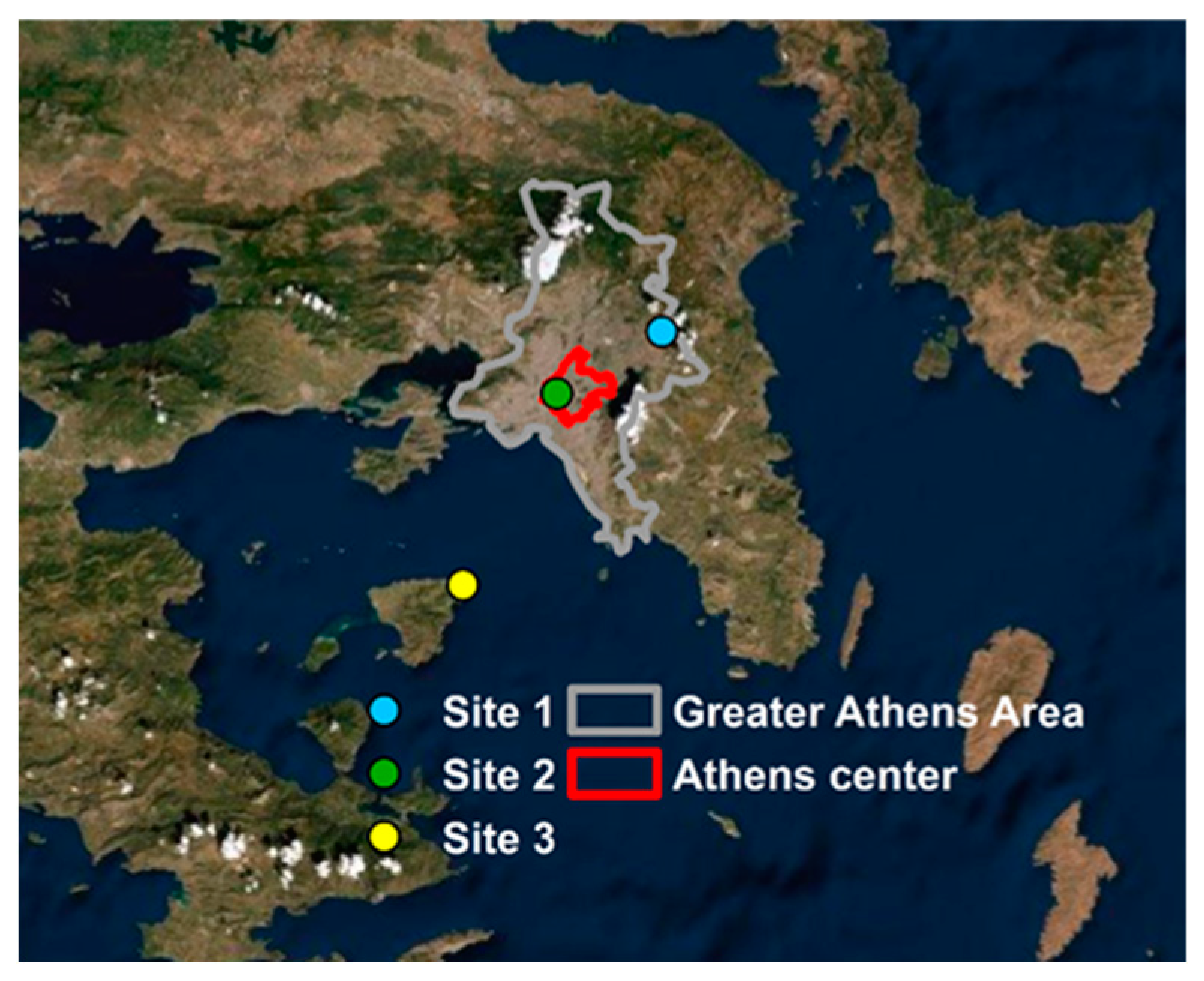
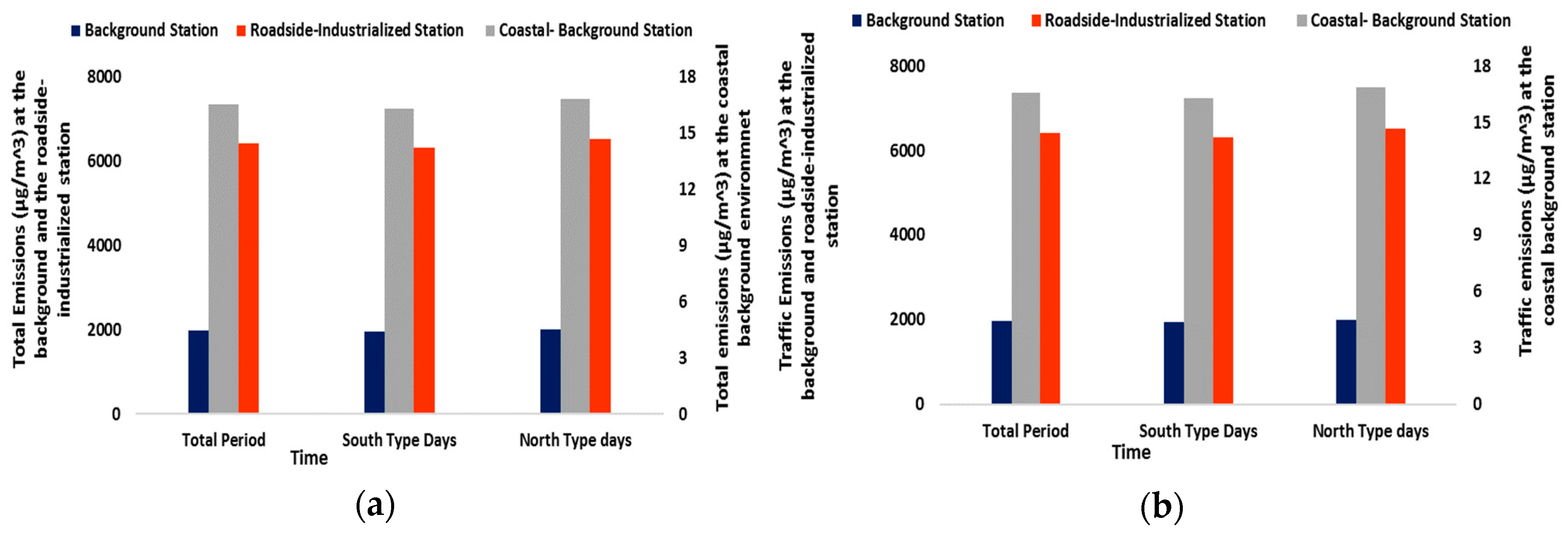
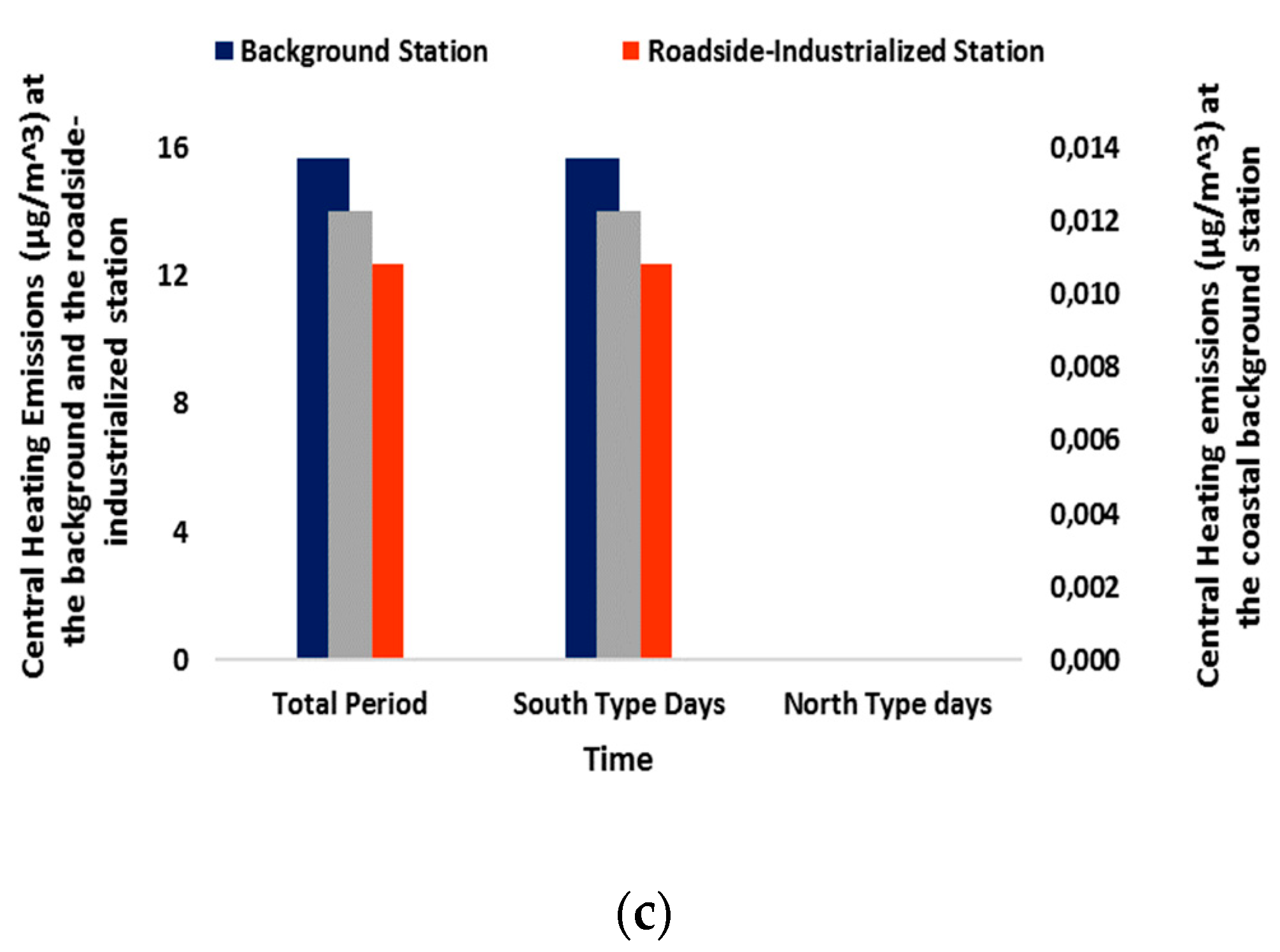
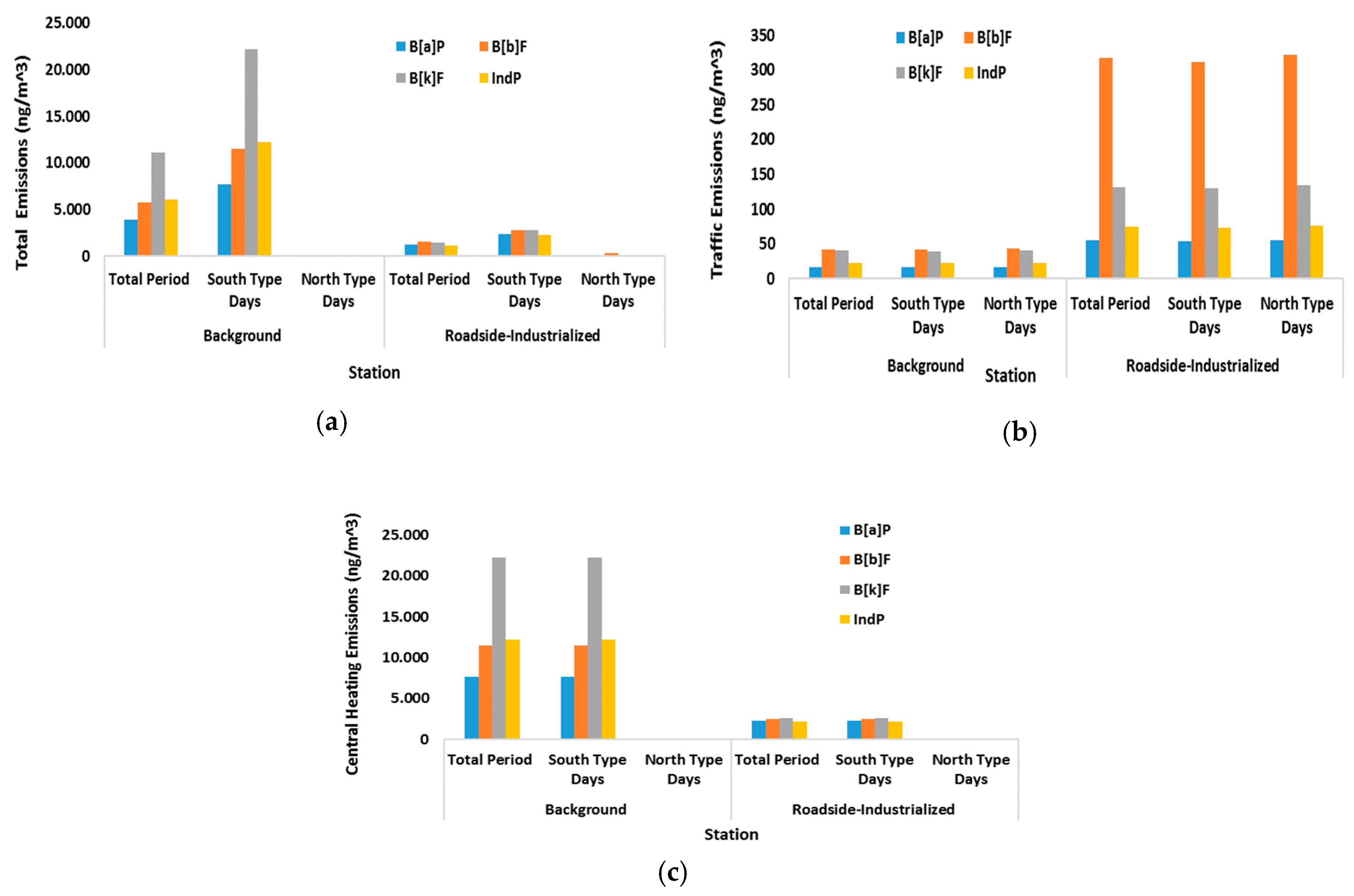
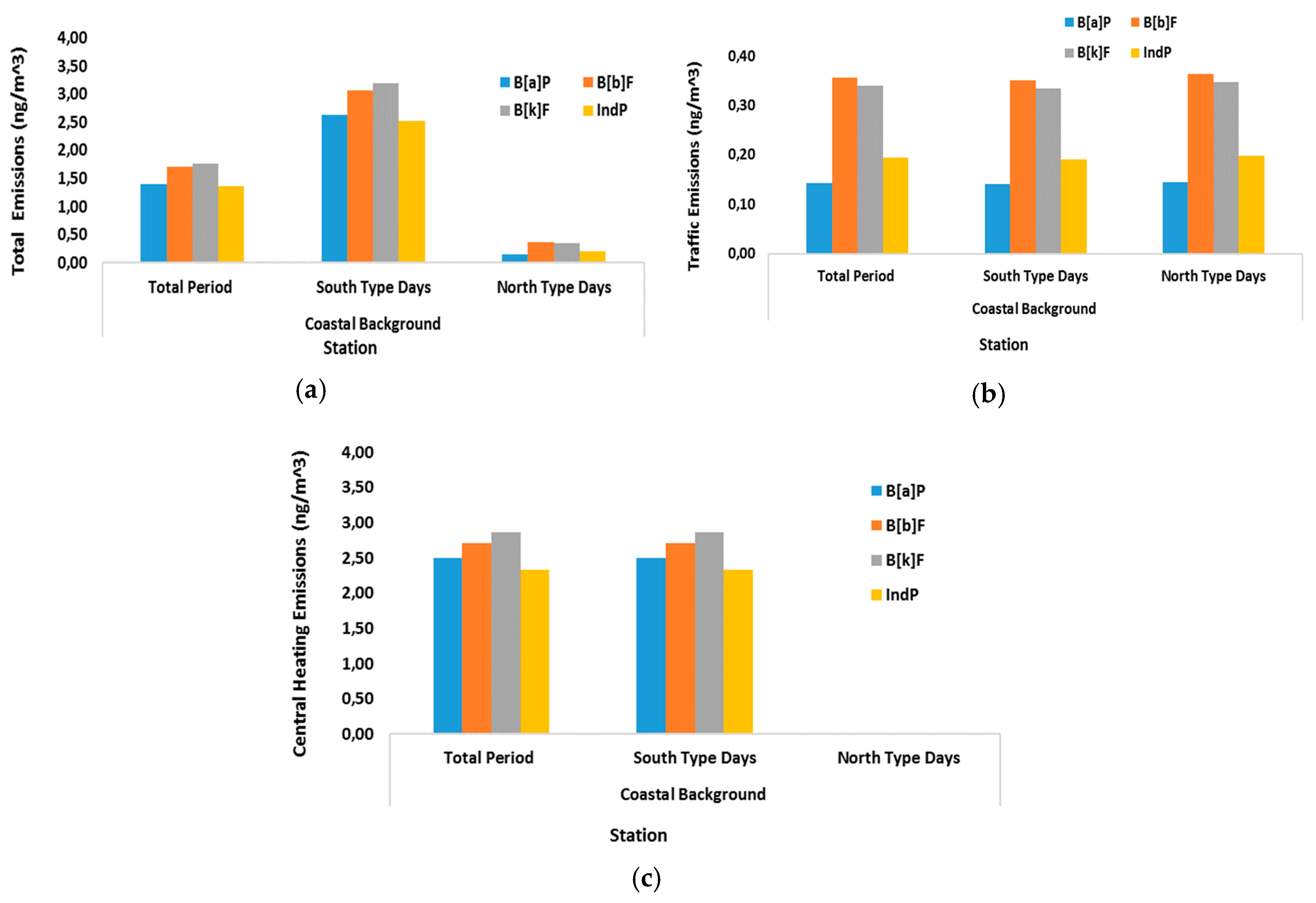

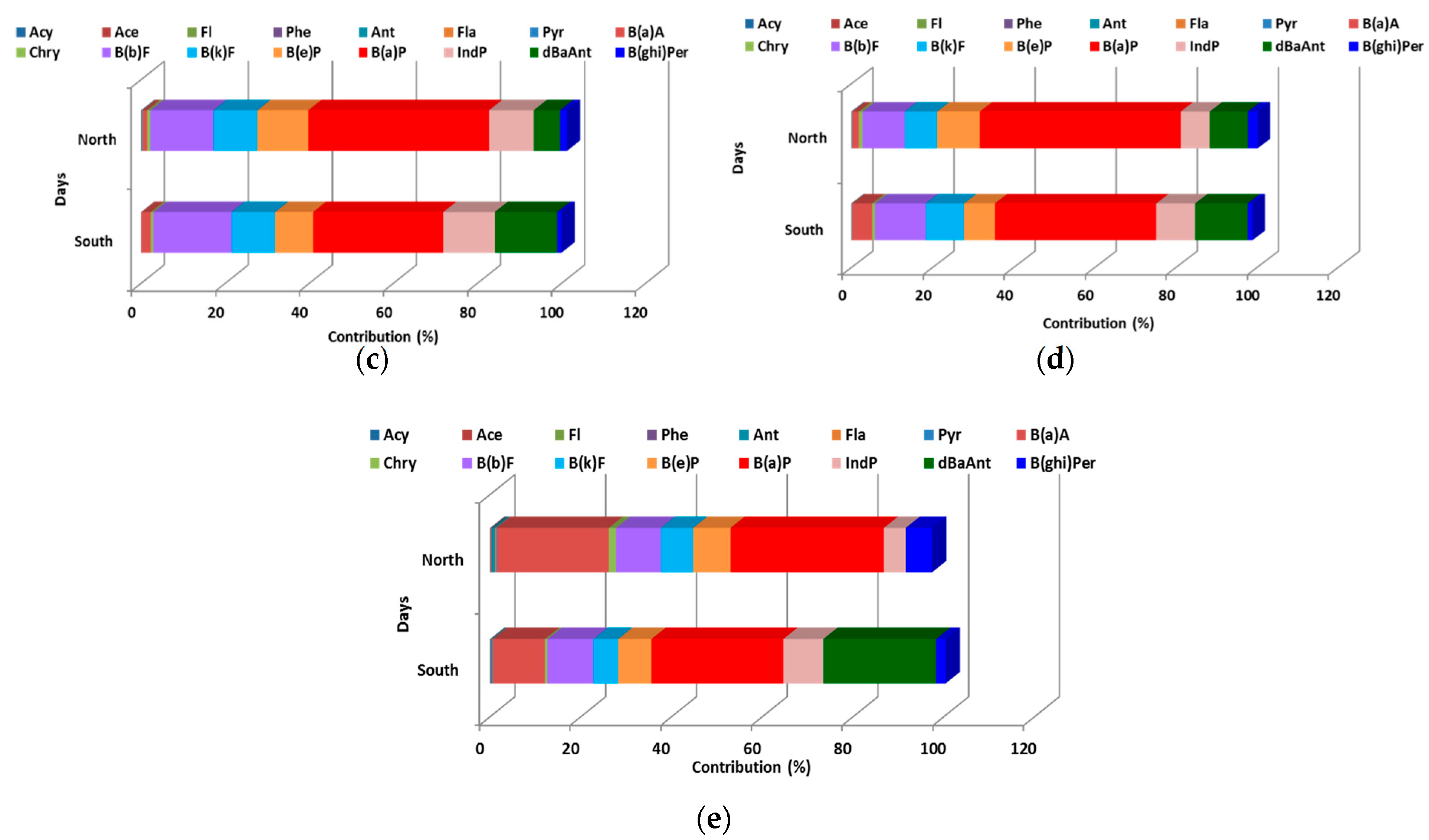

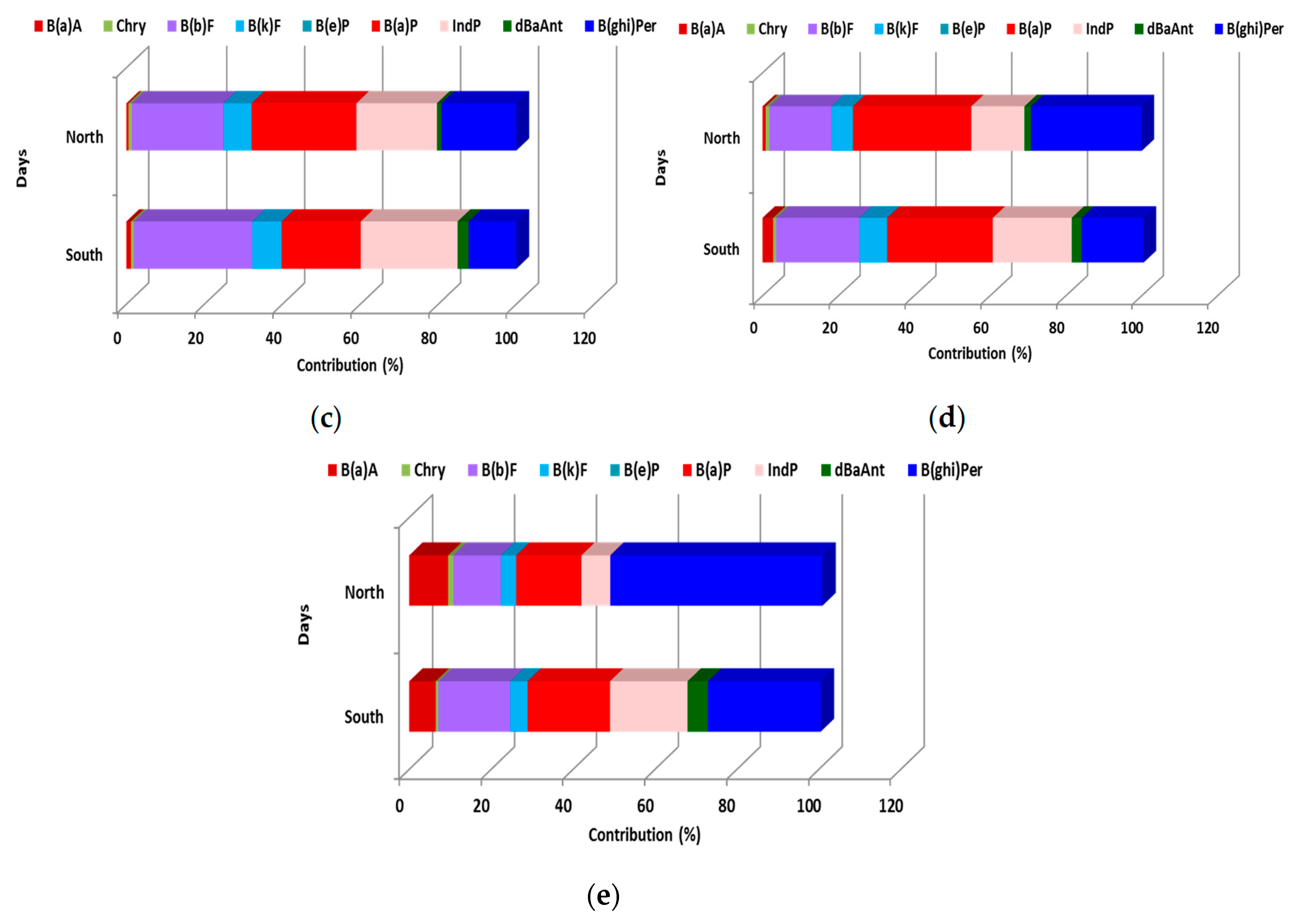
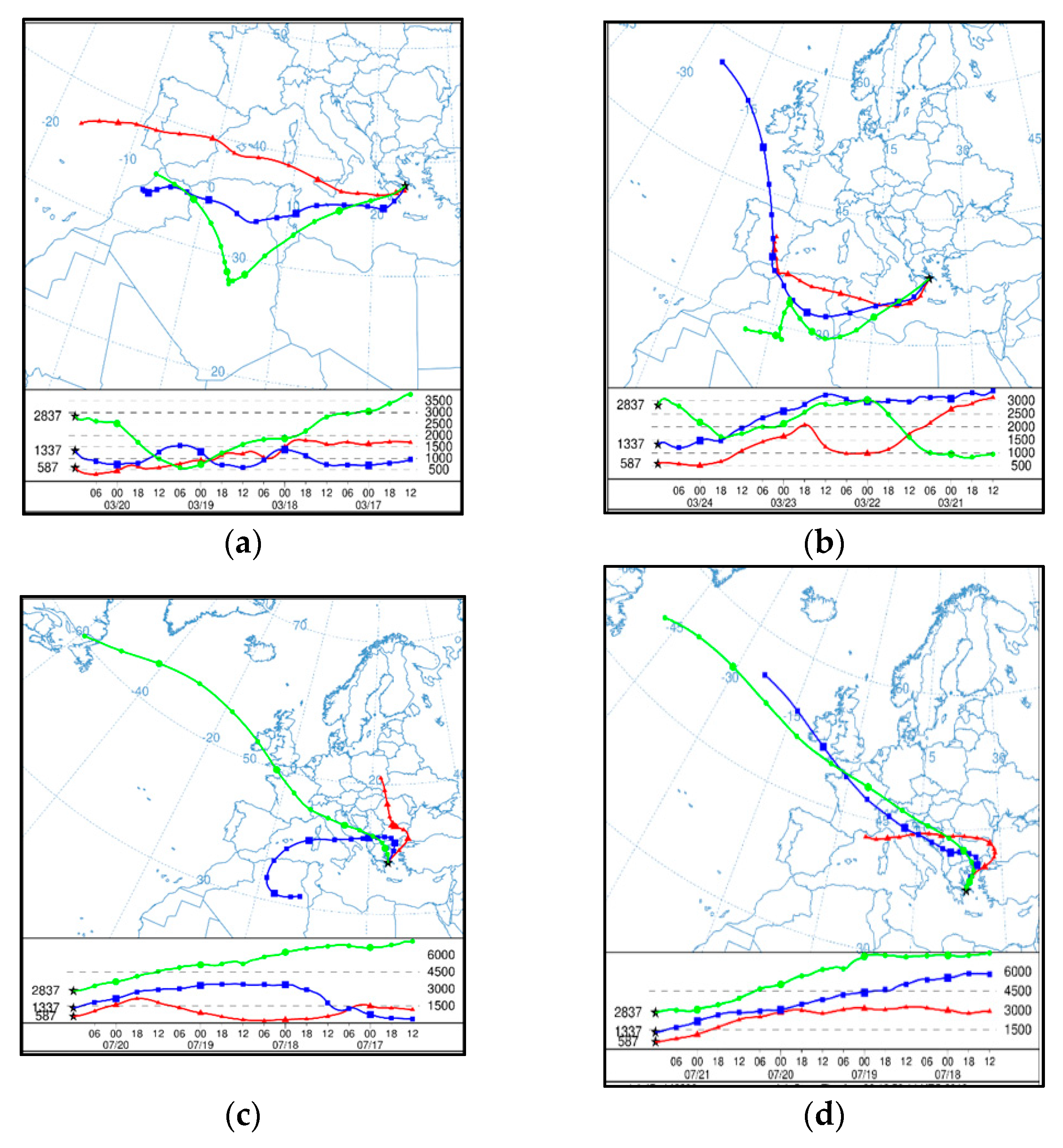
| PM2.5 | PM1 | |||||
|---|---|---|---|---|---|---|
| Station | Background | Roadside-Industrialized | Coastal Background | Roadside-Industrialized | Coastal Background | |
| μg/m3 | PM Mass | 28.8 | 29.1 | 25.7 | 21.8 | 16.9 |
| ng/m3 | Acy | 0.006 | 0.007 | 0.005 | 0.005 | 0.004 |
| Ace | 0.008 | 0.005 | 0.006 | 0.003 | 0.004 | |
| Fl | 0.013 | 0.007 | 0.010 | 0.005 | 0.007 | |
| Phe | 0.046 | 0.044 | 0.061 | 0.029 | 0.028 | |
| 2-MePhe | 0.010 | 0.012 | 0.018 | 0.008 | 0.006 | |
| 1-MePhe | 0.007 | 0.007 | 0.010 | 0.004 | 0.004 | |
| 3,6-dMePhe | 0.004 | 0.003 | 0.007 | 0.003 | 0.003 | |
| Ant | 0.004 | 0.006 | 0.008 | 0.004 | 0.005 | |
| Fla | 0.024 | 0.034 | 0.051 | 0.026 | 0.015 | |
| Pyr | 0.022 | 0.034 | 0.054 | 0.025 | 0.011 | |
| BaA | 0.025 | 0.033 | 0.023 | 0.023 | 0.020 | |
| Chry | 0.036 | 0.106 | 0.074 | 0.069 | 0.011 | |
| B[b]F | 0.066 | 0.316 | 0.100 | 0.254 | 0.013 | |
| B[k]F | 0.035 | 0.224 | 0.076 | 0.143 | 0.008 | |
| B[e]P | 0.037 | 0.183 | 0.089 | 0.127 | 0.010 | |
| B[a]P | 0.015 | 0.060 | 0.043 | 0.044 | 0.004 | |
| Per | 0.013 | 0.023 | 0.028 | 0.018 | 0.014 | |
| IndP | 0.088 | 0.289 | 0.071 | 0.168 | 0.012 | |
| dBaAnt | 0.004 | 0.035 | 0.008 | 0.020 | 0.004 | |
| B[ghi]Per | 0.081 | 0.227 | 0.192 | 0.113 | 0.042 | |
| ΣPAHs | 0.430 | 1.559 | 0.928 | 0.901 | 0.212 | |
| PAHsEPA | 0.371 | 1.331 | 0.779 | 0.818 | 0.176 | |
| 3-ring | 0.092 | 0.091 | 0.120 | 0.061 | 0.057 | |
| 4-ring | 0.108 | 0.207 | 0.202 | 0.143 | 0.054 | |
| 5-ring | 0.124 | 0.791 | 0.336 | 0.443 | 0.049 | |
| 6-ring | 0.106 | 0.471 | 0.270 | 0.254 | 0.052 | |
| LMW | 0.092 | 0.091 | 0.120 | 0.061 | 0.057 | |
| MMW | 0.108 | 0.207 | 0.202 | 0.143 | 0.054 | |
| HMW | 0.230 | 1.261 | 0.606 | 0.697 | 0.101 | |
| PAHsComb | 0.322 | 1.418 | 0.773 | 0.808 | 0.139 | |
| ΣB[a]PTEQ | 0.046 | 0.203 | 0.090 | 0.137 | 0.015 | |
| ΣB[a]PMEQ | 0.082 | 0.311 | 0.140 | 0.205 | 0.023 | |
| PM2.5 | PM1 | |||||
|---|---|---|---|---|---|---|
| DRs | Indicator Sources | Background | Roadside-Industrialized | Coastal Background | Roadside-Industrialized | Coastal Background |
| Ant/Phe + Ant 1 | <0.1 petrogenic 1 >0.1 pyrogenic 1 | 0.07 | 0.29 | 0.11 | 0.13 | 0.11 |
| B[a]P/B[ghi]Per 1 | <0.6 traffic 1 >0.6 non traffic 1 | 0.17 | 0.21 | 0.24 | 0.27 | 0.13 |
| B[a]A/B[a]A + Chry 2 | <0.2 unburned petreleum (petrogenic) 2 >0.35 pyrogenic 2 0.2–0.35 mixture of both 2 | 0.35 | 0.19 | 0.17 | 0.19 | 0.41 |
| B[a]P/B[a]P + Chry 3 | <0.5 diesel vehicles 3 >0.5 gasoline vehicles 3 | 0.17 | 0.33 | 0.28 | 0.31 | 0.26 |
| B[b]F/B[k]F 4 | >0.5 diesel vehicles 4 | 1.75 | 1.41 | 1.31 | 1.75 | 1.63 |
| Fla/Fla + Pyr 5,6 | >0.50 grass/wood/coal combustion 5 0.42–0.53 road dust 6 | 0.50 | 0.49 | 0.53 | 0.51 | 0.55 |
| IndP/IndP + B[ghi]Per 3,5 | <0.2 unburned petroleum (petrogenic) 5 0.2–0.5 petroleum (liquid fossil fuel) combustion 5 >0.5 grass/wood/coal combustion 5 0.2–0.5 petroleum source 3 0.35–0.7 diesel vehicles 3 | 0.48 | 0.44 | 0.32 | 0.48 | 0.20 |
| Fl/Fl + Pyr 7 | >0.5 diesel vehicles 7 <0.5 gasoline vehicles 7 | 0.38 | 0.20 | 0.23 | 0.25 | 0.35 |
| Phe/Ant &Fla/Pyr 8 | <10 & >1 pyrogenic 8 >10 & <1 petrogenic 8 | 10.3 &1.06 | 7.67 & 0.96 | 9.04 &1.12 | 7.13 & 1.04 | 9.20 & 1.23 |
| PM2.5 | PM1 | ||||||
|---|---|---|---|---|---|---|---|
| Concentration | Type | Background | Roadside-Industrialized | Coastal Background | Roadside-Industrialized | Coastal Background | |
| μg/m3 | PM Mass | South | 24.2 | 22.4 | 15.0 | 16.1 | 7.87 |
| North | 33.4 | 35.9 | 36.4 | 27.6 | 26.0 | ||
| ng/m3 | ΣPAHs | South | 0.598 | 2.727 | 0.479 | 1.626 | 0.240 |
| North | 0.262 | 0.391 | 1.377 | 0.176 | 0.184 | ||
| PAHsEPA | South | 0.512 | 2.329 | 0.397 | 1.405 | 0.193 | |
| North | 0.230 | 0.333 | 1.160 | 0.230 | 0.158 | ||
| 3-ring | South | 0.087 | 0.089 | 0.079 | 0.081 | 0.063 | |
| 4-ring | 0.147 | 0.326 | 0.099 | 0.248 | 0.056 | ||
| 5-ring | 0.224 | 1.494 | 0.187 | 0.832 | 0.064 | ||
| 6-ring | 0.141 | 0.819 | 0.114 | 0.465 | 0.056 | ||
| 3-ring | North | 0.097 | 0.093 | 0.162 | 0.040 | 0.051 | |
| 4-ring | 0.068 | 0.088 | 0.305 | 0.038 | 0.051 | ||
| 5-ring | 0.025 | 0.088 | 0.485 | 0.054 | 0.034 | ||
| 6-ring | 0.072 | 0.122 | 0.426 | 0.044 | 0.048 | ||
| LMW | South | 0.087 | 0.089 | 0.079 | 0.081 | 0.063 | |
| MMW | 0.147 | 0.326 | 0.099 | 0.248 | 0.056 | ||
| HMW | 0.364 | 2.312 | 0.301 | 1.297 | 0.120 | ||
| LMW | North | 0.097 | 0.093 | 0.162 | 0.040 | 0.051 | |
| MMW | 0.068 | 0.088 | 0.305 | 0.038 | 0.051 | ||
| HMW | 0.097 | 0.210 | 0.911 | 0.098 | 0.082 | ||
| PAHsComb | South | 0.488 | 2.554 | 0.371 | 1.493 | 0.156 | |
| North | 0.155 | 0.282 | 1.176 | 0.123 | 0.122 | ||
| ΣB[a]PTEQ | South | 0.072 | 0.326 | 0.049 | 0.197 | 0.018 | |
| North | 0.017 | 0.027 | 0.133 | 0.020 | 0.008 | ||
| ΣB[a]PMEQ | South | 0.109 | 0.501 | 0.070 | 0.301 | 0.026 | |
| North | 0.021 | 0.051 | 0.211 | 0.032 | 0.017 | ||
© 2019 by the authors. Licensee MDPI, Basel, Switzerland. This article is an open access article distributed under the terms and conditions of the Creative Commons Attribution (CC BY) license (http://creativecommons.org/licenses/by/4.0/).
Share and Cite
Pateraki, S.; Fameli, K.-M.; Assimakopoulos, V.; Bougiatioti, A.; Maggos, T.; Mihalopoulos, N. Levels, Sources and Health Risk of PM2.5 and PM1-Bound PAHs across the Greater Athens Area: The Role of the Type of Environment and the Meteorology. Atmosphere 2019, 10, 622. https://doi.org/10.3390/atmos10100622
Pateraki S, Fameli K-M, Assimakopoulos V, Bougiatioti A, Maggos T, Mihalopoulos N. Levels, Sources and Health Risk of PM2.5 and PM1-Bound PAHs across the Greater Athens Area: The Role of the Type of Environment and the Meteorology. Atmosphere. 2019; 10(10):622. https://doi.org/10.3390/atmos10100622
Chicago/Turabian StylePateraki, Styliani, Kyriaki-Maria Fameli, Vasiliki Assimakopoulos, Aikaterini Bougiatioti, Thomas Maggos, and Nikolaos Mihalopoulos. 2019. "Levels, Sources and Health Risk of PM2.5 and PM1-Bound PAHs across the Greater Athens Area: The Role of the Type of Environment and the Meteorology" Atmosphere 10, no. 10: 622. https://doi.org/10.3390/atmos10100622
APA StylePateraki, S., Fameli, K.-M., Assimakopoulos, V., Bougiatioti, A., Maggos, T., & Mihalopoulos, N. (2019). Levels, Sources and Health Risk of PM2.5 and PM1-Bound PAHs across the Greater Athens Area: The Role of the Type of Environment and the Meteorology. Atmosphere, 10(10), 622. https://doi.org/10.3390/atmos10100622








